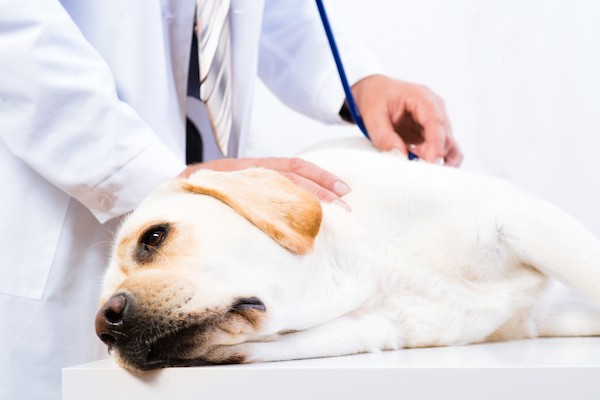For several years I have worked as an emergency veterinarian. As the title implies, that means I treat emergencies. But what is a veterinary emergency anyway? How can you tell whether your dog is suffering from an emergency that requires urgent treatment at 1:00 am, or whether your dog’s problem is something that can wait until the morning? How can you tell when to take your dog to the vet — immediately?

Maltese vet office.
This article will discuss several of the most serious and common veterinary emergencies. It is by no means exhaustive — there are far too many different types of true emergencies to list them all, and there are emergencies that can’t even be imagined before they happen. (If you doubt that, then I urge you to read my story about the dog who put his life at risk by eating a fake breast.)
Many emergencies are not subtle — collapse, paralysis, and hemorrhagic diarrhea come to mind. However, some urgently life-threatening problems, such as bloat, can start with symptoms that don’t seem like a big deal at first.
Several critical emergencies will be described below. If something seems wrong with your dog that does not seem to fit into any of the descriptions, there are some basic guidelines you can follow to assess the urgency of the situation.
First, check your dog’s gums. The gums give a great deal of information about circulation, blood oxygenation, shock, and hemorrhage. The gums normally should be pink and moist; when pressed gently with a finger, the pressed-upon portion should flash white and then turn pink within a second or two. Pale, blue, grey, or red gums signal trouble. It is best to check your dog’s gums regularly when he is not in distress, so that you can know what they normally look like. If your dog seems not well and you discover a difference in gum coloration, then he should receive treatment.
Second, remember that veterinarians — whether they work at emergency practices or at general practices — have telephones. If you’re wondering whether your dog needs treatment, call a vet to describe the situation. The vet should be able to help you decide whether the situation is urgent.
Third, remember that a situation doesn’t have to be life-threatening to warrant veterinary attention. Broken toenails, ear infections, bladder infections, and hot spots are all survivable, but they are also painful and are best treated sooner rather than later if possible.
Finally, if you’re in doubt, the safest course of action is always to seek veterinary attention. If your dog has a mild tummy ache and you take him to the vet, no harm will come to him. But if he’s suffering from bloat and you ignore it, he may be dead by the morning.
Now, let’s get on with the big-time emergencies that require immediate veterinary attention in dogs.

Vet examining dog by Shutterstock.
1. Difficulty breathing
This is the mother of all veterinary emergencies. After three minutes without breathing it’s all over. If your dog is having trouble breathing, or is “breathing funny,” making alarming noises when he breathes, or is puffing his lips when he breathes, you need to get to the vet immediately.
2. Restlessness, panting, inability to lie down comfortably, unsuccessfully attempting to vomit, and abdominal distention
These are all symptoms of gastric dilatation with volvulus, known colloquially as “bloat.” Bloat is one of the most urgently life threatening situations a dog can face. Some dogs will exhibit all of these symptoms, but others may only pant and act restless. Because of its urgency, dogs exhibiting any symptoms suspicious for bloat should be rushed to the nearest veterinarian.
3. Seizures
Although a solitary seizure is not likely to be life threatening, seizures often come in clusters, which can become progressive. And sometimes seizures are caused by toxins that can cause fatal reactions.
4. Collapse or profound weakness
These can be symptoms of major problems such as internal bleeding (particularly a syndrome called hemoabdomen), cardiac compromise due to a condition called pericardial effusion, anaphylactic shock, certain poisonings, a glandular condition called Addison’s disease, and some types of organ failure. All of these problems require urgent veterinary attention.
5. Profuse hemorrhage or major known trauma
These are veterinary emergencies. Profuse hemorrhage is a no brainer. However, dogs who have fallen from height, have been struck by cars, or have been in altercations with much larger dogs can appear unharmed at first, despite suffering major internal injuries.

Golden Retriever getting a vaccine by Shutterstock.
6. Protracted vomiting and/or diarrhea
This is a veterinary emergency, especially if the liquid produced is significantly bloody. A dog who vomits once or has a single loose bowel movement may not require any treatment other than a few hours of resting the stomach and a day or two of bland food. However, repeated vomiting and diarrhea can rapidly lead to life-threatening dehydration; they also can be symptoms of major problems such as gastrointestinal obstruction.
7. Struggling to urinate
This may simply signify a bladder infection. Bladder infections are painful but not life threatening. However, this symptom could also represent obstruction of the urinary tract by bladder stones — a situation that is very urgent indeed. Either way, your pet will be best off by seeing the vet since bladder infections, as mentioned above, are painful.
8. Not eating or drinking
You will have to make a judgement call. If my pal Buster (a Labrador Retriever mix, and quite a chow hound) leaves over a piece of kibble, I know something is wrong. Other dogs may intermittently pass up a meal here or there. However, dogs who go a day or longer without eating almost always are sick. And they usually won’t drink enough water to cover their needs, so dehydration can set in as well.
9. Coughing
This may or may not be a veterinary emergency. It can be caused by something as simple and (relatively) harmless as kennel cough. Or it can be caused by pneumonia or exposure to rat bait. When in doubt, the safest course of action is to go to the vet.
10. Loss of use of rear legs
This is especially common in Dachshunds, Corgis, and other so-called chondrodysplastic (think short legs and long backs) breeds, and can be a sign of injury to the spinal cord. This paralysis or partial paralysis is usually very painful, and rapid treatment can make a big difference in outcome.
11. Severe pain
This is always an emergency. If your dog is vocalizing, panting, profoundly limping, or exhibiting other symptoms of agony, don’t let him suffer. Get to a vet for treatment.
12. Known exposure to dangerous poisons
This should precipitate an immediate veterinary visit. If you catch your dog munching on snail bait, don’t wait for the seizures to start before you go to the vet. Although there are too many dangerous poisons out there to list them all, some of the more common exposures include chocolate, rodent bait, grapes and raisins, human medications, and overdoses of flavored canine medications such as Rimadyl.
The 12 situations listed above are some of the most common emergency situations that dogs face. However, I must reiterate that this list is not exhaustive. And I must also reiterate that if you can’t tell whether your dog needs emergency attention, it’s always safest to take him in.
Next week’s column will discuss all of these emergencies again, but with a new twist. We will discuss what you can do to help your dog and maximize the chance of a successful outcome in each of these situations at home and while you’re on your way to the vet.
Other stories by Dr. Eric Barchas:
- I Hear Gurgling Sounds in My Dog’s Stomach; Should I Worry?
- 11 Hazardous Items to Ban from Your Home if You Have a Dog
- Just How Dangerous Is It to Falsely Call a Pet a Service Dog?
Got a question for Dr. Barchas? Ask our vet in the comments below and your topic might be featured in an upcoming column. (Note that if you have an emergency situation, please see your own vet immediately!)
The post When to Take Your Dog to the Vet Immediately appeared first on Dogster.
No comments:
Post a Comment